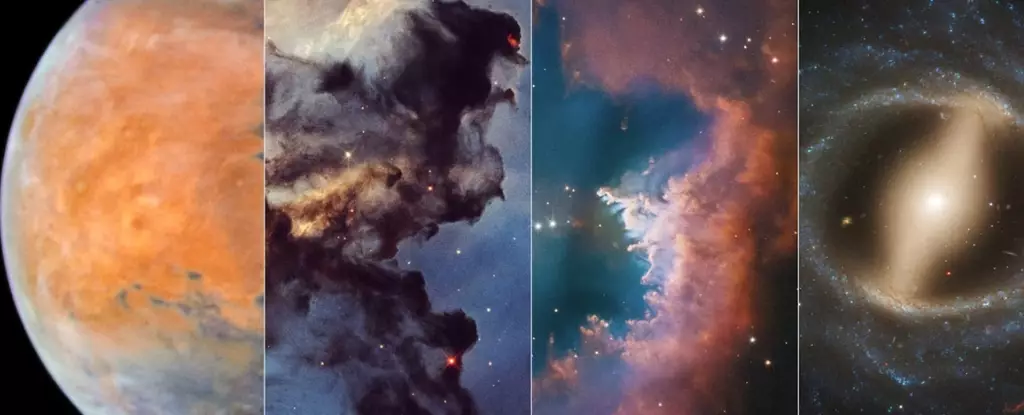This week marks a monumental event in the world of space exploration: the 35th anniversary of the Hubble Space Telescope (HST). Launched aboard the space shuttle Discovery on April 24, 1990, Hubble’s mission has evolved into a remarkable journey through the cosmos, revealing the vast and intricate tapestry of the universe. Instead of receiving accolades in the conventional sense, the Hubble team has opted to share stunning new imagery as part of this celebration, showcasing everything from the rugged detail of Mars to vivid glimpses of distant galaxies. This tradition, which has been upheld for decades, reflects not only Hubble’s achievements but also the intertwined history of human curiosity and technological innovation.
A Journey of Challenges and Triumphs
Though Hubble’s legacy is outlined with brilliance, it certainly wasn’t without its share of challenges. Upon its deployment, it became immediately clear that the telescope’s nearly 8-foot mirror was flawed, casting doubt over the mission’s future. However, through human determination and ingenuity, astronauts conducted the first of several servicing missions in 1993, rectifying the optical issues and unleashing Hubble’s true potential. This pivotal moment in history not only salvaged an invaluable astronomical object but also set the stage for unprecedented advancements in our understanding of the cosmos. The resilience exemplified during these early tribulations exemplifies the spirit of exploration, where setbacks often catalyze innovation.
A Treasure Trove of Scientific Discoveries
Hubble’s significant contributions to science are mind-boggling. With nearly 1.7 million observations across more than 55,000 astronomical targets, Hubble has become an essential instrument in unraveling the mysteries of the universe. It has unveiled critical findings — from the enigmatic nature of dark energy that’s causing the universe to accelerate in its expansion to the study of exoplanets that might harbor conditions suitable for life. The telescope has catalyzed over 22,000 research papers, enriching not only academic discourse but also engaging public interest, which demonstrates its influence extends far beyond the walls of research institutions.
The recent images released to commemorate Hubble’s anniversary exhibit the telescope’s versatility. A snapshot of Mars captures its bright orange Tharsis plateau, alongside dormant volcanoes and wispy polar ice clouds, encapsulating the planet’s dynamic landscape. Likewise, the Rosette Nebula’s portrayal reveals the delicate dance of stellar formation, where dark clouds are silhouetted against brilliant colors of cosmic dust. Hubble has a unique ability to stimulate our imagination, making us look up, ponder, and dream about the mysteries that lie beyond our world.
A Pioneering Legacy Amid New Horizons
Even as we celebrate Hubble’s accomplishments, attention is beginning to shift toward its successor, the James Webb Space Telescope (JWST), launched in 2021. Equipped with the ability to capture images in infrared, JWST surpasses Hubble in light-gathering capability, but lacks Hubble’s broader spectrum of observable light. JWST’s positioning at a gravitational balance point a million miles away means it cannot be serviced, leaving a future without on-orbit repairs that Hubble benefitted from multiple times.
However, the vision for the future remains bright with the proposed Habitable Worlds Observatory (HWO). Planned for launch in the 2040s, HWO aims not only to produce sharper images than Hubble but also to explore the tantalizing prospect of identifying Earth-like planets orbiting distant stars. This mission encapsulates humanity’s enduring quest to answer fundamental questions about our place in the universe while reinforcing the need for ongoing investment in space technology. The Habitable Worlds Observatory would be designed with robotic servicing capabilities, ensuring that it can be maintained in a way Hubble can, thus promising a new era of exploration and discovery.
Reflecting on Hubble’s Lasting Impact
Hubble’s operational legacy is immeasurable. The telescope has ignited passions for astronomy and science among the public, serving as a gateway to understanding the cosmos. Its breathtaking imagery and critical discoveries have inspired generations, intertwining art and science in a uniquely compelling manner. Hubble remains more than just a scientific instrument; it is a symbol of what humanity can achieve when we dare to dream and reach for the stars. As we look back on its illustrious career, we recognize that Hubble’s journey is not merely a celebration of technology, but an affirmation of our inexhaustible curiosity to unveil the secrets of the universe.

